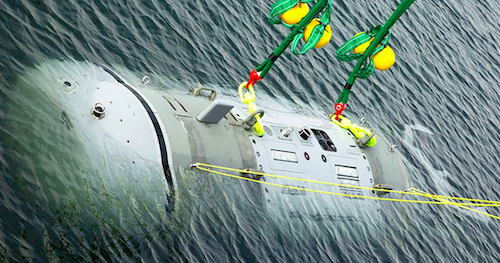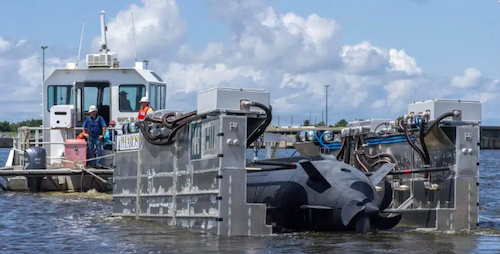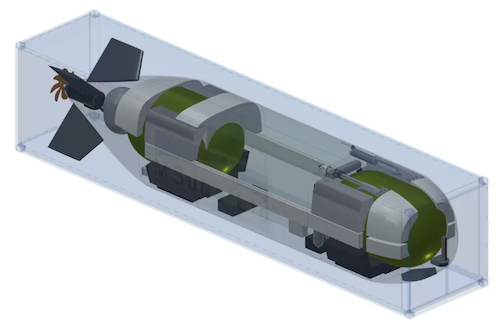AUKUS Augmented: AUVs, Mines for the RAN

Given the lengthy AUKUS timetable, and the increasingly contentious Indo-Pacific security environment, the Royal Australian Navy (RAN) may look to autonomous underwater vehicles (AUVs), in combination with offensive mine warfare, to hedge against delivery delays and interim undersea warfare capability gaps.
-
The AUKUS timetable stretches over two decades. The agreement calls for forward basing of U.S. and U.K. submarines by 2027, with Australia purchasing three Virginia-class submarines (with an option to buy two more) in the early 2030s. A joint U.S.-U.K. platform, SSN-AUKUS, will be delivered to the RAN beginning in the early 2040s.
-
AUKUS could cause the A$6 billion Collins-class Life of Type Extension (LOTE) program to be rolled back, with any delay in Virginia-class deliveries placing further operational strain on Australia's aging indigenous fleet of conventionally-powered (diesel-electric) submarines.
-
Several factors could adversely impact the AUKUS timetable, including scheduling delays, domestic politics, budget pressures, as well as supply chain disruptions brought on by global economic conditions, or the outbreak of regional armed conflict.
The Royal Australian Navy (RAN), through its partnership with Trusted Autonomous Systems, a Defense Cooperative Research Center, is currently seeking to acquire a fleet of extra-large autonomous underwater vehicles (XL-AUVs).
-
Australia is exploring commercial off the shelf (COTS) platforms to accelerate the procurement process. There are currently two models under consideration - the "Sea Wolf" from Cellula Robotics, and "Ghost Shark" from Anduril Industries.
-
Ghost Shark is a larger, more capable version of its predecessor, the Dive-LD, a large displacement AUV (LD-AUV), which Anduril secured in its acquisition of Dive Technologies in February of 2022. Ghost Shark will feature a 3D printed hull, and will be integrated into Anduril's proprietary battlespace operating system, Lattice.

-
Sea Wolf is a variant of Cellula's large displacement AUV (LD-AUV), the Solus-LR. It is 12 meters in length, and 1.7 meters in diameter, and can reach depths of 3000 meters. It is equipped with a hydrogen fuel cell power system, providing it with a range of 2000 kilometers (1080 nautical miles).

The RAN could also seek to acquire a COTS LD-AUV, such as the Kongsberg Hugin Endurance.
-
The Endurance is 10 meters long and 1.2 meters in diameter. It is equipped with a fuel cell power system, and is capable of fully autonomous operations for a period of fifteen days (Range: 1200 nautical miles).
-
To provide an ongoing deterrent, a fleet of Hugins could be deployed on a rotational basis, either from a pier, or over the side of a surface ship, in accordance with the "rule of thirds" - one third of the fleet is deployed as one third is returning to base, while the remaining third is undergoing recharge or maintenance.
-
If fitted with warheads, these vehicles could potentially be used to structure a mobile minefield within the water column, holding both submarines and surface ships at risk.
Both the United States and United Kingdom have indigenous XL-AUV platforms under development, which could mature before the early 2030s, when the first Virginia-class boats are due to enter RAN service.
-
Boeing is currently developing the Orca XL-AUV, a larger version of its Echo Voyager platform.

-
The program has been plagued by scheduling delays and cost overruns. A total of five Orcas are currently on order, with an original (2019) contract value of $43 million. While a dedicated test asset was delivered and launched in April, 2022, according to a September, 2022, Government Accountability Office (GAO) report, the program is now at least $242 million over original estimates, and three years late. (Boeing was to deliver the first vehicle in 2020, and all vehicles by the end of 2022.)
-
The USN had been developing an LD-AUV, Snakehead, but after fourteen years and over $200 million, the USN recently recommended discontinuing the program. After a brief attempt by lawmakers to keep the program alive, Congress ultimately agreed with the Navy's recommendation. Although Snakehead may officially be discontinued, technologies and know-how could still be salvaged for other programs.

-
The Navy cited design problems as the main reason for its recommendation - specifically, the vehicle's incompatibility with improved submarine drydeck shelters, its principal means of launch and recovery. But the viability of surface launch and recovery was recently demonstrated by Huntington Ingalls using its Pharos launch/recovery system, which would enable Snakehead, or other LD/XL-AUVs to be launched and recovered from well deck-equipped vessels. Whether this will influence Snakehead's fate as a program of record is unknown.

-
The Royal Navy (RN) is partnering with British submersible manufacturer Msubs to develop the Cetus XL-AUV. Cetus is approximately 12 meters long, and 2.2 meters in diameter, and will be compatible with a standard forty foot shipping container.

-
Under the AUKUS Undersea Robotics and Autonomous Systems (AURAS) project, the U.S., U.K., and Australia are to collaborate on the development of AUVs. According to an April, 2022 White House AUKUS fact sheet, "initial trials and experimentation of this capability are planned for 2023." The specific nature and extent of this collaboration are unknown.
LD and XL-AUVs are largely unproven in naval operations, and their future remains largely undefined and uncertain.
-
At best, these platforms are still several years away from entering on duty with the RN or USN.
-
Given the Orca's production problems, as well as its single-mission focus (clandestine minelaying), it is unlikely that the USN would be in a position to offer XL-AUVs to Australia by the end of this decade.
-
In addition to the platforms themselves, a robust framework of tactics, techniques, and procedures (TTPs) will need to be developed and refined before they can be integrated into USN and RN fleet operations.
-
At this time there appears to be no plan to arm large or extra large AUVs. Whether a wide-area sensor net of LD or XL-AUVs would pose a credible threat to the People's Liberation Army Navy (PLAN), and thereby deter Chinese maritime aggression in Australian waters is unknown.
To bolster its sea denial capability, the RAN is also seeking to acquire an inventory of "smart" sea mines, allocating up to A$1 billion for the purchase of an unknown quantity from an undisclosed European manufacturer. Three potential sources are RMW Italia, a unit of Rheinmetall, DA-Group of Finland, and Forcit Defence, also of Finland. A third company, SH Defense of Denmark, could also be in the mix.
- RMW Italia manufactures and markets the Murena and Astoria bottom influence mines.
- DA-Group of Finland manufactures and markets the Turso MM30 bottom influence mine, as well as a containerized mine deployment system called Sumico, which enables up to twelve mines to be rolled off the stern of a vessel of opportunity.
- Forcit Defence of Finland manufactures the Blocker bottom influence mine, which is compatible with DA-Group's Sumico system.
- Depending on the RAN's needs, a third company, SH Defense of Denmark, markets a system of containerized defense platforms called Cube, including a mine deployment system similar to the Sumico system, offering greater flexibility in terms of the quantity and type of mines that can be deployed.
- If AUKUS is extended to unmanned systems, and Australia takes delivery of Orca XL-AUVs, the United States could also provide the RAN with Hammerhead encapsulated torpedo mines, which are being purpose-built for deployment by the Orca XL-AUV. (Hammerheads could also be provided if another compatible deployment platform is developed.)
AUKUS is a landmark agreement for Australian national security, but it is accompanied by several risks - political (domestic, regional, global), budgetary, and economic - and will require decades to be fully realized. During that period, China's naval expansion and aggressive maritime operations in the Indo-Pacific region will likely intensify. The RAN intends to acquire advanced sea mines, which would bolster its sea denial capability and also act as a hedge against AUKUS-driven risks. The RAN may seek to further hedge these risks by investing in a fleet of AUVs (XL or LD), which could serve both as sensor nodes within a wide-area ISR network, thereby expanding the RAN's situational awareness, and as kinetic effectors to deter PLAN maritime aggression.

